TLM Review
This section provides a basic introduction to TLM ports, exports, interfaces, and sockets as well as basic rules for connecting them. See the References section for more in-depth materials, including the IEEE 1666-2011, the SystemC LRM that defines the TLM standard.
| TLM Review | |
| This section provides a basic introduction to TLM ports, exports, interfaces, and sockets as well as basic rules for connecting them. | |
| Terms | Definitions of terms used throughout this document. |
| Context Independence | The purpose of TLM is to allow components to be self-contained, independent of the myriad ways they might be connected in a testbench. |
| Ports | Ports are used to call interface methods implemented elsewhere. |
| Interfaces & Imps | An interface in SC and an imp in SV UVM are used to expose to the outside world an implementation of a standard TLM interface, which is a group of methods with predefined signatures and semantics. |
| Exports | Exports promote an interface (or imp) implementation from a child to its parent. |
| Analysis | Analysis ports, exports, and imps are used to monitor transaction flow and help you debug your designs. |
| TLM Initiator Socket | Sockets are a convenient way to make TLM2 connections; in fact, most TLM2 connections are made with sockets, not individual interface connections. |
| TLM Target Socket | A component having a target socket receives transaction on its forward interface and, if non-blocking, sends responses to the initiator via the backward path. |
| Socket Connections | A socket is used to connect a forward and backward path between an initiator and target using a single connect or bind call. |
| Legal TLM Connections | TLM port connections are like Verilog module port connections except you’re connecting interfaces not wires. |
| TLM Generic Payload | TLM 2.0 defines a canonical transaction type, tlm_generic_payload, or tlm_gp for short. |
| TLM1 combination interfaces | TLM ports require a connection to an implementation of its interface type, while TLM exports, interfaces, and imps provide the implementation. |
| UVMC TLM Connections | Getting your SystemC TLM models and SystemVerilog UVM components talking to each other breaks down to two steps |
Terms
Definitions of terms used throughout this document.
| SV | SystemVerilog, or UVM in SystemVerilog. The context will make clear which. In figures, UVM SV components are shown in blue. |
| SC | SystemC. In figures, SC components are shown in yellow. |
| model | Functionality encapsulated by a class. A model is typically a subtypes (derived from) of sc_module in SC and uvm_component in SV. Although dynamic in nature, models deriving from these classes are quasi-static; they are created during elaboration of the testbench and continue to exist throughout simulation. |
| component | Synonymous with model, above. |
| hierarchical component | A model contains one or more models. |
| TLM | Transaction-Level Model. TLM models exchange information as objects, not the discrete signals or wires you see in RTL. Transactions abstract away the low-level RTL details in exchange for speed and easier maintenance. To be reusable, TLM models should communicate via standard TLM1 or TLM2 interfaces. |
| interface | A class that defines one or more method prototypes but does not implement them. Classes inheriting from an interface must implement the methods defined in the interface. TLM1 and TLM2 define several interfaces for transaction-level communication. Models that implement an interface are referred to as targets. |
| imp | SV only. Like an interface, except instead of providing an interface implementation through inheritance, the imp is an object that provides an interface through delegation. It is a SV workaround to lack of multiple inheritance. |
| export | An object that conveys (exports) an interface implementation from the child to the parent level. Exports can also be connected to other exports for purposes of promoting the interface implementation as high in the model hierarchy as needed. |
| port | An object through which interface calls are made. A port is connected to the interface implementation via a combination of parent port-export-imp connections. Thus, calls to a port in an initiator component end up calling the method implementations in the target component, with neither the initiator nor target knowing about each other. |
Who initiates requests and who services them dictates the control flow relationship between models.
| initiator | A component that initiates transaction requests. Initiators typically contain at least one port or initiator_socket. |
| target | A component to which transaction requests are sent. Targets typically implement an interface (SC) or contain at an initiator_socket or imp. |
Who creates the transactions and who processes them dictate the data flow relationship between models.
| producer | A component that produces transactions. |
| consumer | A component that consumes or executes transactions. |
There are thus four combinations of control and data flow possible for any given TLM connection.
- Initiator-producers create transactions and send them out TLM ports or sockets.
- Target-consumers receive transactions from initiator-producers via TLM exports, interfaces, imps, or sockets. Initiator-consumers request transactions from target-producers via TLM ports or sockets.
- Initiator-consumers request transactions from connected target-producers. Although it does not use a standard TLM interface, the UVM driver is an example of a initiator-consumer.
- Target-producers create transactions upon request from initiator-consumers. Although not a component using standard TLM, the UVM sequencer is an example of a target-producer, accepting requests for transactions from the driver.
Context Independence
The purpose of TLM is to allow components to be self-contained, independent of the myriad ways they might be connected in a testbench. Likewise, connections should be not depend on the components’ internal implementation details. The TLM standard defines the set of common interfaces and semantics required to make successful connections to independently developed components.
Provided the IP you intend to integrate has properly applied the principles of context independence and TLM connectivity, mixed-language interoperability with UVMC can be achieved with no modifications to the IP on either side of the language boundary.
The examples included in this kit reinforce these concepts. All examples are fully documented with diagrams, explanations, and code in hyperlinked HTML. Together they show you step-by-step how to integrate existing IP in a mixed SystemC / SystemVerilog environment.
Ports
Ports are used to call interface methods implemented elsewhere.
- Ports are the “starting point” for communication by initiators
- The testbench developer (integrator) connects ports external to the owner of th eport.
- Ports are depicted as square in diagrams
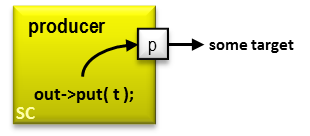
SC Example
class producer : public sc_module
{
sc_port<tlm_blocking_put_if<packet> > out; <--
producer(sc_module_name nm) : out("out"){
SC_THREAD(run);
}
void run() {
packet t;
...initialize/randomize packet...
out->put(t); <--
}
};SV Example
class producer extends uvm_component
{
tlm_blocking_put_port #(packet) out; <--
`uvm_component_utils(producer)
function new (string name, uvm_component parent=null);
super.new(name,parent);
out = new("out", this);
endfunction
virtual task run_phase (uvm_phase phase);
packet t = packet::type_id::create("tr",this);
t.randomize();
`uvm_info("PRODUCER/PKT/SEND", t.sprint(),UVM_MEDIUM)
out.put(t); <--
endtask
};Interfaces & Imps
An interface in SC and an imp in SV UVM are used to expose to the outside world an implementation of a standard TLM interface, which is a group of methods with predefined signatures and semantics. The interface is typically a small subset of a component’s overall API. Thus, the TLM interface and imp minimize the coupling between components by exposing only the standard portion of its API.
- Imps/interfaces are “end points” in a network of port/export/interface connections
- Inteface methods are called via ports bound to the interface/imp, NOT directly
- Interfaces/imps are depicted as a circle in diagrams
SC Example
In SC, target components inherit the interface & implement the interface’s methods
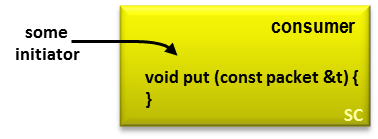
class consumer : public sc_module,
tlm_blocking_put_if<packet> <-- interface inherited
{
public:
consumer(sc_module_name nm) { }
virtual void put(const packet &t) { <-- implementation
cout << "Got packet: " << t << endl;
wait(10,SC_NS);
}
};SV Example
In SV, target components provide an “imp” object for connecting to the outside world. The imp delegates to the interface implementations provided in the component.
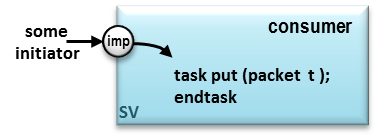
class consumer extends uvm_component;
uvm_blocking_put_imp #(packet,consumer) in; <-- imp object
`uvm_component_utils(consumer)
function new(string name, uvm_component parent=null);
super.new(name,parent);
in = new("in", this);
endfunction
virtual task put (packet t); <-- implementation
`uvm_info("CONSUMER/PKT/RECV",
t.sprint(),UVM_MEDIUM)
#10ns;
endtask
endclassExports
Exports promote an interface (or imp) implementation from a child to its parent.
- Promotes (exports) interface implementations from a child (or self) up a level
- Internally bound to child export, imp / interface in c’tor
- Externally connected to port or parent export, but not required. (If no connection, no activity)
- Exports are depicted as circle in diagrams
SC Example
Often, an SC component that implements an interface may provide that interface via an explicit export object, much like the imp provides an interface in SV. In this case, the SC Target binds its own interface implementation to the export. Then, a port can be connected directly to the export, e.g. prod.out.bind(cons.in);
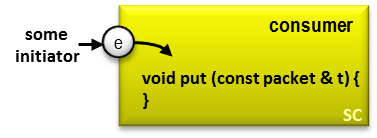
class consumer : public sc_module,
tlm_blocking_put_if<packet>
{
public:
sc_export<tlm_blocking_put_if<packet> > in; <-- export
consumer(sc_module_name nm) : in("in") {
in(*this); <-- promote own intf impl
}
virtual void put(const packet &t) {
cout << "Got packet: " << t << endl;
wait(10,SC_NS);
}
};SV Example
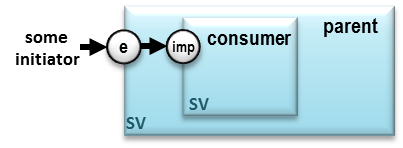
class parent extends uvm_component;
uvm_blocking_put_export #(packet) in;
consumer cons;
`uvm_component_utils(consumer)
function new(string name, uvm_component parent=null);
super.new(name,parent);
in = new("in", this);
endfunction
function void build_phase(uvm_phase phase);
cons=consumer::type_id::create("const",this);
endfunction
function void connect_phase(uvm_phase phase);
in.connect(consumer.in);
endfunction
endclassAnalysis
Analysis ports, exports, and imps are used to monitor transaction flow and help you debug your designs. Components emitting transactions out an analysis port are not necessarily the producers of those transactions. In all cases, components receiving transactions from an analysis connection do not execute them or modify them in any way.
Analysis Ports
Analysis ports are a special kind of TLM port. They publish transactions to any number of listeners, including zero.
- Broadcasts (“publishes”) to all connected targets (“subscribers”)
- Transactions are read-only. Used for debug, scoreboards, etc.
- Usually does not require connection (SC_ZERO_OR_MORE_BOUND)
- Depicted as diamond in diagrams
SC Example
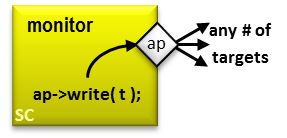
class monitor: public sc_module
{
sc_port<tlm_analysis_if<packet>,
0, SC_ZERO_OR_MORE_BOUND> > ap;
monitor(sc_module_name nm) : ap("ap"){
SC_THREAD(run);
}
void run() {
packet t;
...gather packet off bus...
ap->write( t ); <--
}
};Analysis Exports & Imps
Analysis exports and imps are subscribers to a TLM analysis port.
- Receives streams of transactions from connected publisher (e.g. monitor)
- Transactions are read-only, i.e. for debugging, scoreboarding, etc.
- Like all exports and imps, does not typically require a connection
- Depicted as circle in diagrams
SV Example
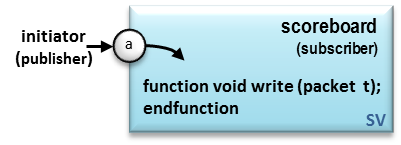
class scoreboard extends uvm_component;
uvm_analysis_imp #(packet,scoreboard) actual_in; <-- imp
`uvm_component_utils(scoreboard)
function new(string name, uvm_component parent=null);
super.new(name,parent);
actual_in = new("actual_in", this);
...
endfunction
virtual function void write(packet t); <-- called by actual_in
packet exp;
`uvm_info("SB/PKT/RECV",t.sprint(),UVM_MEDIUM)
if (!expect_fifo.try_get(exp)) ...error
if (!t.compare(exp)) ...error
endfunction
endclassTLM Initiator Socket
Sockets are a convenient way to make TLM2 connections; in fact, most TLM2 connections are made with sockets, not individual interface connections.
- Can do blocking or non-blocking transport (usually one or the other)
- Default type is tlm_generic_payload with base protocol semantics
- Initiator must implement backward interface, unless a simple initiator socket is used (in tlm_utils namespace)
- When driving an SV target, the DMI and debug interface calls will be ignored, as they are not implemented in SV.
- When driving an SC target from SV, the DMI and debug interfaces will not be called, so your SC models should not rely on them being called.
- Depicted as square with outward facing arrow
SC Example

struct producer: public sc_module,
public tlm_bw_transport_if< >
{
tlm::tlm_initiator_socket< > out; // default: tlm_gp
producer (sc_module_name nm) : out("out") {
out(*this); // bind bw intf to self
SC_THREAD(fw_proc);
}
// FORWARD PATH
void fw_proc() {
// produce tlm gp trans, then emit using...
out->b_transport(t,del);
*or*
out->nb_transport_fw(t,ph,del);
}
// BACKWARD PATH
virtual tlm_sync_enum nb_transport_bw(...) {
...coordinate with fw path, per protocol
}
virtual void invalidate_direct_mem_ptr(...) {
// Dummy implementation
}
};TLM Target Socket
A component having a target socket receives transaction on its forward interface and, if non-blocking, sends responses to the initiator via the backward path.
Some other key aspects of target sockets include
- They implement both blocking or non-blocking transport interface, although the connected initiator typically uses one or the other.
- The default transaction type is the tlm_generic_payload executed with TLM base protocol semantics
- The target model must implement all of forward interface unless the simple target socket is used, in which case only those methods that are registered need to be implemented.
- Because UVM SV does not support the direct memory and debug interfaces, UVMC stubs these out. Attempts to use these interfaces by SV initiators will be ignored.
- Sockets are depicted in diagrams as a square with inward facing arrow.

SC example
struct consumer: public sc_module,
public tlm_fw_transport_if< > {
tlm::tlm_target_socket< > in;
consumer(sc_module_name nm) : in("in") {
in.bind(*this); SC_THREAD(bw_proc);
}
// FORWARD PATH
void b_transport( packet& trans,sc_time& t ) {
// fully execute request, modify args, return
}
tlm_sync_enum nb_transport_fw(...) {
// per protocol, update args as allowed,return
}
bool get_direct_mem_ptr() { return FALSE; }
unsigned int transport_dbg() { return 0; }
// BACKWARD PATH
void bw_proc() {
...coordinate with fw transport per protocol
in->nb_transport_bw(trans,ph,delay);
}
};Socket Connections
A socket is used to connect a forward and backward path between an initiator and target using a single connect or bind call. Although sockets support both blocking and non-blocking semantics, typically only one of them is in play for any given connection.
Blocking Transport
- Initiator indirectly calls b_transport in Target
- Initiator must not modify transaction; transaction contents invalid until b_transport returns
- When b_transport returns, transaction is complete with status/results
- Transaction can be reused in next b_transport call

Non-blocking Transport using Base Protocol
- Initiator starts request by calling nb_transport_fw in Target. Target returns with updated arguments.
- Target can call nb_transport_bw in Initiator at phase transitions. To provide Initiator updates; Initiator may respond via fw interface.
- Transaction contents, phase, & delay can change. Only certain fields in certain phases, according to base protocol rules.
- Transport calls continue back and forth until either returns transaction complete status. For efficiency, the same transaction handle is used throughout its execution.
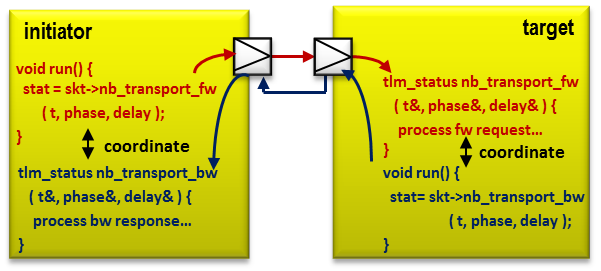
Legal TLM Connections
TLM port connections are like Verilog module port connections except you’re connecting interfaces not wires. Control and data flow through each TLM connection can be in opposite directions.
A successful connection requires a given pair of ports to agree on the interface and transaction types as well as the direction of control and data flow.
| Ports | Ports can connect/bind to parent ports, sibling exports, and sibling interfaces/imps. prod.port.bind(port|export|intf|imp) |
| Exports | Exports can connect/bind to child exports and child interfaces/imps. export.bind(export|imp|interface) |
| Interfaces (SC) | Interfaces in Systemc are pure virtual classes that are inherited by target. They are never on the left-hand side of a bind or connect call. |
| Imps (SV) | Imps in SV are implicitly bound to the parent in the parent’s constructor. imp = new(“name”, this), where this is the parent. They are never on the left-hand side of a bind or connect call. |
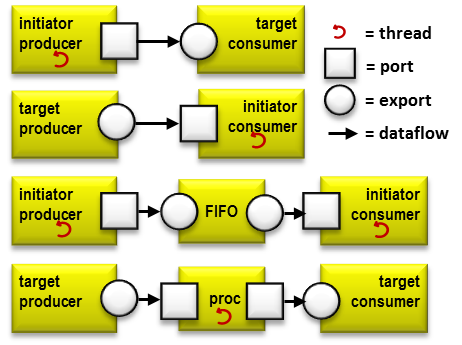
A connection is hierarchical when a port connects to a parent port or an export connects to a child export, interface, or imp. The following figure shows the legal port-export-imp-interface connections. Passthrough TLM sockets in SV UVM are used to make hierarchical socket connections.
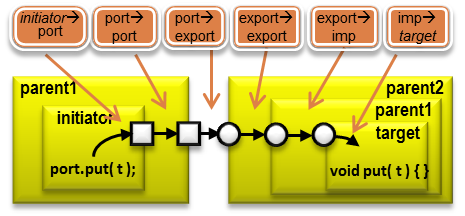
TLM Generic Payload
TLM 2.0 defines a canonical transaction type, tlm_generic_payload, or tlm_gp for short. TLM 2.0 also defines a base protocol for execution of the generic payload over standard initiator and target sockets.
When used together--tlm_gp with the base protocol--interoperability potential is at its highest.
The TLM GP defines the following major fields.
| command | READ, WRITE, or IGNORE |
| address | Base address |
| data | Data buffer. An array of bytes |
| data_length | Number of valid bytes in data buffer |
| response_status | OK, INCOMPLETE, GENERIC_ERROR, ADDRESS_ERROR, BURST_ERROR, etc. |
| byte_enable | Byte-enable data buffer |
| byte_enable_length | Number of valid byte-enables buffer |
Between SystemC, UVM, and the UVMC libraries, the tlm generic payload transaction definitions and converters come pre-defined for you. You do not need to define converters for tlm_gp. You can just connect and go!
TLM1 combination interfaces
TLM ports require a connection to an implementation of its interface type, while TLM exports, interfaces, and imps provide the implementation. As long as the provider provides at least the required interface, the connection is allowed.
In most connections, you will be connecting TLM ports that are typed to matching interfaces, e.g. a uvm_tlm_blocking_put_port #(my_trans) would be connected to a uvm_tlm_blocking_put_imp #(my_trans), or in SC, an sc_port< tlm_blocking_put_if<my_trans> > would be connected to a component implementing (inheriting) tlm_blocking_put_if<my_trans>.
To increase connection options for integrators, a VIP designer may opt to provide both the blocking and non-blocking interfaces, e.g. provide a uvm_tlm_put_imp #(my_tras). Integrators may connect to this any of uvm_tlm_blocking_put_port #(my_trans), uvm_tlm_nonblocking_put_port #(my_trans), or of course uvm_tlm_put_port #(my_trans).
As you will see in the chapter on UVMC Connections, the same options when making connections that cross the language boundary.
UVMC TLM Connections
Getting your SystemC TLM models and SystemVerilog UVM components talking to each other breaks down to two steps
- Define converters, if necessary
- Make connections
If you’re not using the TLM generic payload, you must define compatible transaction classes in SV and SC and the converters to go between them. If the transactions and the components that use them are pre-existing, this task entails writing a custom converter class that not only packs and unpacks but adapts to the differences in member types, member number, and declaration order between the two classes.
If a transaction type pre-exists in one language but not the other, you would need to define the missing transaction type first, then define the converters to go between it and the original transaction. Try to define the class to match the existing definition as closely as possible.
In UVM, your transaction should extend uvm_sequence_item. It must implement the do_pack and do_unpack methods, or it must use the `uvm_field macros (not recommended). The number, order, and manner of unpacking must be compatible with that for unpacking. Typically, one is the exact reverse of the other.
//------------------------------------------------------------// // Copyright 2009-2015 Mentor Graphics Corporation // // All Rights Reserved Worldwide // // // // Licensed under the Apache License, Version 2.0 (the // // "License"); you may not use this file except in // // compliance with the License. You may obtain a copy of // // the License at // // // // http://www.apache.org/licenses/LICENSE-2.0 // // // // Unless required by applicable law or agreed to in // // writing, software distributed under the License is // // distributed on an "AS IS" BASIS, WITHOUT WARRANTIES OR // // CONDITIONS OF ANY KIND, either express or implied. See // // the License for the specific language governing // // permissions and limitations under the License. // //------------------------------------------------------------//